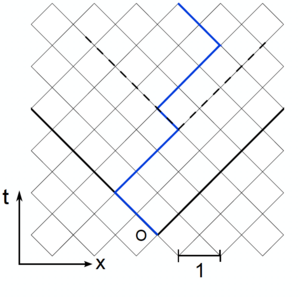L-3
Goal: This lecture is dedicated to a classical model in disordered systems: the directed polymer in random media. It has been introduced to model vortices in superconductur or domain wall in magnetic film. We will focus here on the algorithms that identify the ground state or compute the free energy at temperature T, as well as, on the Cole-Hopf transformation that map this model on the KPZ equation.
Polymers, interfaces and manifolds in random media
We consider the following potential energy
The first term represents the elasticity of the manifold and the second term is the quenched disorder, due to the impurities. In general, the medium is D-dimensional, the internal coordinate of the manifold is d-dimensional and the height filed is N-dimensional. Hence,the following equations always holds:
In practice, we will study two cases:
- Directed Polymers (), . Examples are vortices, fronts...
- Elastic interfaces (), . Examples are domain walls...
Today we restrict to polymers. Note that they are directed because their configuration is uni-valuated. It is useful to study the model using the following change of variable
Directed polymers
Dijkstra Algorithm and transfer matrix

We introduce a lattice model for the directed polymer (see figure). In a companion notebook we provide the implementation of the powerful Dijkstra algorithm.
Dijkstra allows to identify the minimal energy among the exponential number of configurations
We are also interested in the ground state configuration . For both quantities we expect scale invariance with two exponents for the energy and for the roughness
Universal exponents: Both are Independent of the lattice, the disorder distribution, the elastic constants, or the boudanry conditions. Note that , while for an interface .
Non-universal constants: are of order 1 and depend on the lattice, the disorder distribution, the elastic constants... However is independent on the boudanry conditions!
Universal distributions: are instead universal, but depends on the boundary condtions. Starting from 2000 a magic connection has been revealed between this model and the smallest eigenvalues of random matrices. In particular I discuss two different boundary conditions:
- Droplet: . In this case, up to rescaling, is distributed as the smallest eigenvalue of a GUE random matrix (Tracy Widom distribution )
- Flat: while the other end is free. In this case, up to rescaling, is distributed as the smallest eigenvalue of a GOE random matrix (Tracy Widom distribution )
Entropy and scaling relation
It is useful to compute the entropy
From which one could guess from dimensional analysis
We will see that this relation is actually exact.
Back to the continuum model
Let us consider polymers of length , starting in and ending in and at thermal equlibrium at temperature . The partition function of the model writes as
For simplicity, we assume a white noise, . Here, the partition function is written as a sum over all possible paths, corresponding to all possible polymer configurations that start at and end at , weighted by the appropriate Boltzmann factor.
Polymer partition function and propagator of a quantum particle
Let's perform the following change of variables: . We also identifies with and as the time.
Note that is the classical action of a particle with kinetic energy and time dependent potential , evolving from time zero to time . From the Feymann path integral formulation, is the propagator of the quantum particle.
In absence of disorder, one can find the propagator of the free particle, that, in the original variables, writes:
Feynman-Kac formula
Let's derive the Feyman Kac formula for in the general case:
- First, focus on free paths and introduce the following probability
- Second, the moments generating function
- Third, the backward approach. Consider free paths evolving up to and reaching :
Here is the average over all free paths, while is the average over the last jump, namely and .
- At the lowest order we have
Replacing we obtain the partition function is the solution of the Schrodinger-like equation:
Remarks
Remark 1:
This equation is a diffusive equation with multiplicative noise. Edwards Wilkinson is instead a diffusive equation with additive noise. The Cole Hopf transformation allows to map the diffusive equation with multiplicative noise in a non-linear equation with additive noise. We will apply this tranformation and have a surprise.
Remark 2: This hamiltonian is time dependent because of the multiplicative noise . For a time independent hamiltonian, we can use the spectrum of the operator. In general we will have to parts:
- A discrete set of eigenvalues with the eigenstates
- A continuum part where the states have energy . We define the density of states (DOS) , such that the number of states with energy in is .
In this case can be written has the sum of two contributions:
Exercise: free particle in 1D
- Step 1: The spectrum
For a free particle there a no discrete eigenvalue, but only a continuum spectrum. In 1D the hamiltonian is . Show that the continuum spectrum has the form
Here is a real number, while is a positive number. Note that the states are delocalized on the entire real axis and they cannot be normalized to unit but you impose the Dirac delta normalization:
- Step 2: the DOS
For a given energy there are two states
Use the definition of DOS
ans show that for both
you have :
- Step 3: the propagator
Use the spectral decomposition of the propagator to recover . Tip: use .
Cole Hopf Transformation
Replacing
You get
The KPZ equation!
We can establish a KPZ/Directed polymer dictionary, valid in any dimension. Let us remark that the free energy of the polymer is
At low temperature, the free energy approaches the ground state energy, .
| KPZ | KPZ exponents | Directed polymer | Directed polymer exponents |
|---|---|---|---|
We conclude that
Moreover, the scaling relation is a reincarnation of the Galilean invariance .